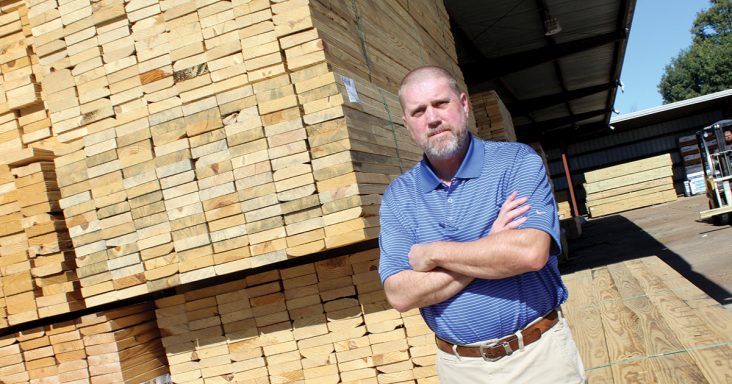Higher building material prices the result of ‘perfect storm’ of factors
by July 13, 2021 12:28 pm 1,913 views

Matt Gordon, commodity buyer for E.C. Barton & Co. in Jonesboro.
A number of factors combined to produce what E.C. Barton and Co., commodity buyer Matt Gordon called a perfect storm around the price and availability of building materials, a storm that recently has begun to ease somewhat.
Gordon, who has been in the hardware and lumber business his entire working career said of the past 18 months, “It’s been a strange ride. … It was a perfect storm.”
The National Association of Home Builders (NAHB) recently reported that shortages of materials in June were more widespread than at any time since 1990 and that shortage translated into higher prices. Though prices have receded lately, there is debate over whether those price drops are long term or only temporary.
“A lot of the insiders I deal with think it’s short-term,” Gordon said. “But I hope we can get back to some regular numbers.”
Though often characterized as a supply-and-demand issue, that seems an oversimplification.
Gordon said in 2020 historically low interest rates fueled a building boom and the receipt of stimulus checks by homeowners across the country was a significant factor in driving the pricing situation we’re seeing. Many homeowners decided to undertake home repair or renovation projects and others may have added decks or fences.
“They had stimulus money and were ready to spend it,” he said.
In addition, inventory was low in some instances. Workers had been sent home from lumber mills and there was a shortage of trucks, making it difficult for mills to get materials produced and delivered. It’s not just one area that contributed to the rise in prices and increase in demand, Gordon said.
Since April of 2020, the NAHB said the cost of lumber has increased 180%, adding significantly to the average price of a single-family home.
“Escalating lumber prices are largely due to insufficient domestic product and extremely large mill curtailments that lasted well into the 2020 building season,” the NAHB said.
Bob Troutt, a Jonesboro developer, builder and realtor, agreed.
“We began to really see [material prices] begin to rise late in 2020,” he said.
A 4-by-8-foot sheet of oriented strand board cost about $8 in late 2019, but by late 2020 was in the $20 to $21 range, Troutt said. The price by mid-2021 had risen as high as $57, but has now dropped to around $50 a sheet. In some cases, Troutt said builders may have decided to not take on the construction of a house without a buyer already lined up.
“In this marketplace, [peak price of materials] kind of puts you out of spec home building because the appraisal won’t match the material price,” Troutt said. “Prices are coming down, but they’re never going to go back to $8 a sheet. But if they get to $18 to $20, builders could live with that. Some builders are playing musical chairs, but they can’t quit. If they ever quit, there won’t be a seat for them.”
NAHB said the spike in prices over the past 12 to 15 months added $36,000 to the average price of a new single-family residence. Troutt said the situation “has affected every spectrum” of his costs, not just lumber. He said cabinets that once cost $6,000 are now $11,000.
“When one group increases their price, all people, you name it, increase their price. Now we’ve got a bit of a shortage in the labor market. … It’s all across the board,” he said.
Nevertheless, Troutt said buyers are still there because of low interest rates. However, if mortgage rates rise significantly, some buyers may no longer qualify for a loan. For many buyers, it’s all about the payment.
“If the rate is 4.5%, that is not attainable,” he said. For example, a 2,060 square-foot house recently sold for $288,000. Troutt built a similar house in Bobcat Meadows prior to the commodity inflation and it sold for $250,000.
“There’s no difference in the two houses and lots,” he said.
Troutt said the situation is the same across the country, citing the example of a friend who moved to the Charlotte, N.C., area and is looking for a new home just north of Charlotte. The house is 1,800 square feet in size and is priced at $379,000, or $210 per square foot.
Gordon said Arkansas is fortunate to be a market in which southern yellow pine is a primary framing material, something that is not the case in other parts of the country. Arkansas produces a large amount of southern yellow pine.
However, he said he has had difficulty getting the lumber out of the forests and to the mills.
“Just because of the shortage of help. There’s still some of that,” he said.
